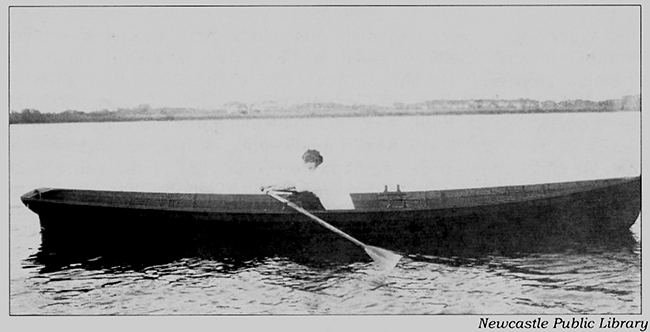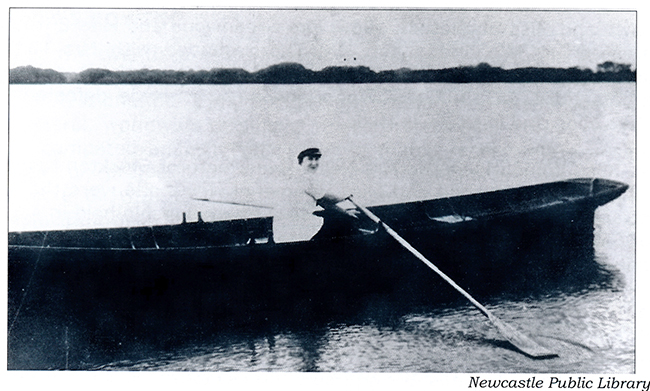History of Newcastle Rowing Club
Part 3 -Twentieth Century Rowing in Newcastle (continued)
Part 3 pages: 1, 2, 3, 4, 5, 6
Women's Rowing
Early in the twentieth century, women's rowing in Australia gathered momentum. As prize money was involved, much of that rowing was on a professional basis which was ironic seeing that it coincided with the general, worldwide decline of men's professional rowing. Women either competed against each other in match races, within a small number of professional rowing clubs available in Sydney and Newcastle or with the few men's amateur clubs that catered for women. But any foothold gained was precarious with occasional advances offset by periods of stagnation.
Historical highlights for ladies professional rowing were:
- The inaugural Ladies Sculling Championship of Australia was raced in 1907 for prize money of £25.
- Early professional clubs included the Ladies Boat Club (1895) in Adelaide and the Pioneers Ladies' RC (1913) and the Double Bay Ladies RC (1915), both of which were in Sydney.
For amateurs, historical highlights were:
- The first women's club was Albert Park Ladies (1907) in Melbourne. The first in NSW was Western Suburbs Ladies RC (later Sydney Ladies RC) in 1909 followed by the YWCA club in 1929.
- The Australian Women's Amateur Rowing Council was formed in 1920.
- An interstate women's four-oared championship became an annual event in 1920.
- The first (amateur) Australian Women's Championship of Australia was in 1963.
- Women's rowing was included in the Olympics in 1976.
Within this context locally, the Belmont L!dies Boating Club (c 1929) is noteworthy. Nothing is known about it but it seems likely that it was short lived. The absence of any news coverage suggests that it gained no prominence and had few members. A surviving club photograph shows twenty-four people, presumably all members, appearing to range from teenagers to mature women.
Australian sporting records refer to "the first serious" (sic) women's sculling race in Australia" as having occurred in Melbourne in 1901: an event regarded as "another sporting breakthrough for women". As we have seen, NRC was responsible for the inclusion of a very serious race for ladies in a regatta in 1873.
In 1905, some of Newcastle's most prominent women rowers entered the first race for ladies to be included in a Newcastle Annual Regatta since 1872. Mrs Rose Woodridge and Mrs Thoroughgood defeated Mrs
Brown and Miss Hughes. In 1906, Mrs Greenwood and Miss E Hughes defeated Mrs Woodridge and Mrs Thoroughgood with Mrs Latham (probably Susan - another sister of Ben Thoroughgood) and Miss Latham third. In 1907 Mrs Woodridge and Mrs Hyde defeated Mrs Greenwood and Miss Nellie Hyde.
Mrs Rose Woodbridge and Mrs Nellie Hyde, both of Stockton together with Mrs A Greenwood and Miss Hughes of Newcastle were the local entrants in the NSW Ladies Double Scull Championship held in August 1906 over 1 1/i miles of the Parramatta River course. Beforehand, the various crews were reported to be putting in some interesting training with long rows twice a day combined with running, jumping, skipping and exercising with dumbbells. At least two crews were said to be hardening their muscles at the punching bag. A newspaper report said that the crews "continue to do as much work daily as if they were men. This is a mistake and quite unnecessary".

Phillis Hughes, in an 18' pleasure boat
Heats of the championships (in 16 ft pleasure boats with coxswain) were held on a Wednesday and final the following Saturday. Greenwood and Hughes were eliminated in the heats, the boats providing no pleasure on this occasion. For the final Woodbridge and Hyde were at pre-race odds of 8 to 1 behind the more fancied Lewis sisters from Sydney. The Novocastrians (shown below in second place) rowed in "brilliant style" to win a fiercely contested in the last few strokes by half a boat length in a time of 12112 minutes. Prize money was £20.

Millie Greenwood also in an 18' pleasure boat
Mrs Woodridge rowed against Australia's first women's sculling champion, Mrs Gertie Lewis of Sydney, for the Australian Championship and a stake of £50 (£25 each) in 18 foot pleasure skiffs over two miles on the Parramatta River on 23 February 1907. Mrs Woodridge's boat weighing 172 lbs was lighter than Mrs Lewis' so had to carry 7 lbs to equalize their weights. Mrs Lewis retained the title. At the Raymond Terrace course on 25 May of the same year, Mrs Hyde defeated Mrs Woodridge by 10 lengths for the ladies championship of the Hunter and £20.

The Ladies Nearing Mortlake the Leading Crews being misses Lewis and Mrs Woolbridge and Mrs Hyde
The Novocastrians
Mrs Hyde rowed for the Championship of Australia and £25 a side against the titleholder Miss Gertie Lewis of Sydney on 21 August 1909. The race in 18 ft pleasure boats was held over two miles on the Parramatta River. The race was said to be poor - Miss Lewis won by 30 lengths - and the attendance worse. Mrs Hyde was described in the Newcastle Morning Herald as less skilled than her opponent rowing short with a "choppy" stroke. Both rowers had met and defeated Mrs Woodridge previously.
Mrs Woodridge again rowed Miss Lewis on 2 September 1911 for the Championship of Australia and £25 a side. As before, the race was held on the Parramatta River over two miles. Boats were 18 ft club skiffs. Miss Lewis was odds-on favourite and won an exciting race.
Members of a famous Newcastle sporting family, Mrs Latham (nee Thoroughgood) combined with one of her sons (both of whom were rowers) in a mixed double sculls event at a regatta on the Parramatta River in October 1916. Then over 60 years old, Mrs Latham was said to "row with vigour and neatness that was surprising".
Miss Hughes won the Hunter River Professional Sculling Club's ladies championship on 14 April 1917. The club was the first club in Newcastle to accept women as members.
Yet, even though by then there were women's rowing clubs in existence and races for women were being included in regatta programs more often, some resistance remained. In 1914 for instance, the chairman of the Sydney Anniversary Regatta, Judge Blackhouse, was quoted as saying that "he hoped he would never see women racing at the regatta. Rowing was hard work and was the very worst thing for women. Among savage races where women did manual labour they were hags before they were 40". It's enough to make Australian women savage.
By the 1920s a new generation of lady rowers emerged in Newcastle. Most notable were Miss Phyllis Hughes and Millie Greenwood, both from families with a strong rowing background. The ladies were keen rivals in internal races for the championship of the Hunter River Professional Sculling Club. In 1923, Miss Hughes who held the ladies sculling championship of Lake Macquarie challenged Miss Greenwood for the championship of the Hunter River and £100. The race was over 1 1h miles in 18 ft dingheys. Miss Hughes won.
As with men's rowing, women's rowing disappeared from Newcastle by the mid-1930s, re-appearing several decades later with the emergence of new rowing clubs, some of which were school-based,to become a permanent part of the Australian rowing scene.
As if to make up for lost opportunities, women now make up over half of NRC's membership.
Part 3 pages: 1, 2, 3, 4, 5, 6
Previous < Newcastle Rowing Club in Colonial Newcastle
Next > The Modern Era, 1992 -
